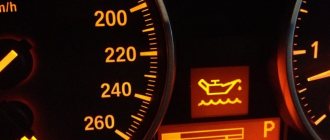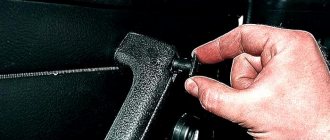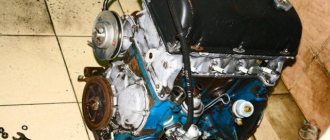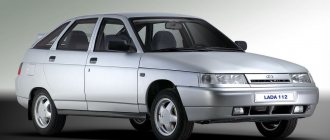The engine is the main power unit of any car. The VAZ 2106 is no exception - the legendary “six”, which first came off the assembly line of the Togliatti automobile plant back in 1975, but continues to be popular to this day. It is the engine of this car and its main technical characteristics that will be discussed in our article.
History of the VAZ 2106 power unit
The growing automobile market of the Soviet Union was replenished with a new Zhiguli model - VAZ 2106. The car received an updated body design, soft suspension and a new, powerful, dynamic engine.
The sixth model of Zhiguli was not created from scratch. This is a modified and modified version of 2103. The Lada 06 model differs from the 03 in a more powerful power unit, with a volume of 1.6 liters and a power of 75 hp, the wiring diagram and the external design of the car have changed.
If we compare the sixth model of Zhiguli with the numerous Moskvich cars at the end of the seventies and eighties, the difference was huge. The six's interior had a comfortable interior, embossed front seats with headrests, excellent sound insulation, and a dashboard with a tachometer. All this comfort was the height of prestige for Soviet car enthusiasts. We must not forget about the main thing, the new high-speed engine with excellent dynamics for that time. The VAZ 2106 engine developed a maximum speed of 150 km per hour, and could accelerate to 100 km per hour in 16 seconds, which was the best indicator at that time.
“Six” became so popular and in demand that the Volzhsky plant simply did not have time to produce 1.6 liter power units. Then in 1979, in order to meet the growing needs of Soviet citizens, it was decided to produce the sixth model of Zhiguli with less powerful engines. So the VAZ 21061 had an engine from the Lada 2103. The VAZ 21063 was equipped with an engine whose volume was 1.3 liters, power 69 horsepower. This is the native engine of the Zhiguli VAZ 21011. These cars combined the comfort of the sixth model and a weak engine that did not meet the desires of the citizens of the USSR. But in the situation of automobile shortage in the late 70s, this was the only way out of the current situation.
VAZ 2106 was periodically changed and improved. Initially, the sixth model used a Solex carburetor, and in 1980 it was replaced with an Ozone carburetor. The electrical wiring has been upgraded several times. In 1977, the wiring technology and terminal design changed. And in 1986, they began to install a new relay on the “Six”. In 1988, the exhaust system underwent modernization and a disposable nut began to be used.
In 1990, AvtoVAZ mastered a new configuration of the sixth model of the Luxury class - Lada 21065. The Six modification was produced with the original 2106 engine, but it was equipped with a contactless coolant, and a Solex carburetor was used for power. In the cabin, the upholstery and headrests were improved, the lighting was also improved, and halogen headlights were installed.
Simultaneously with 21065, a modernization of the export Zhiguli VAZ 21064 appeared. They installed: a VAZ 2103 engine with a volume of 1500 cc, a powerful generator, a rear window observer, spectacular VAZ 2105 bumpers, but most importantly, a five-speed gearbox was used here. This significantly increases engine efficiency when driving on the highway, reduces fuel consumption and reduces engine noise.
Subsequently, five-speed gearboxes began to be installed on most of the “Sixes” intended for the domestic automotive market. Currently, the VAZ 2106 has technically and morally lost its advanced position, but quite often you can find well-maintained VAZ 2106 on the roads of the entire post-Soviet space.
How to use an online calculator
Converting kilowatts to horsepower using a calculator is done as follows:
- At the top left , select metric units - watts or kilowatts.
- From below, select the type of “horses” - metric, English or electric (in practice, metric ones are most often used).
- At the top, enter the number in the appropriate cell: if you need to convert kW to hp, enter the number in the left cell, if vice versa, enter the number in the right cell.
- To enter fractional numbers, use the comma (“,”) separator character.
Description of the VAZ 2106 1.6 liter engine
In the second half of the 70s, AvtoVAZ designers decided to create a more powerful and dynamic engine. They realized their plans by creating the legendary VAZ 2106 engine.
This power plant is a union of two engines, from which all the most progressive features are taken:
- We are talking about the first model of the VAZ 2103. From this model, a cylinder block increased in height and a crankshaft with an enlarged crank mechanism by 7 millimeters were taken. Due to this, the distance of movement of the piston increased to 80 mm;
- the second donor for the 06 model is the VAZ 21011 engine. From here the cylinder diameter was increased by 3 mm. Instead of the previous 76mm, it became 79mm. The piston diameter increased accordingly. The connecting rod remained the same as on the 01 Zhiguli.
The changes described above made it possible to create a successful internal combustion engine model of that time. The engine turned out to be dynamic, reliable, and more powerful. And given the price of AI 93 fuel in those days, it was also an economical engine.
What are kilowatts (kW)
Watt is the SI unit of power, named after the inventor J. Watt, who created the universal steam engine. The watt was adopted as a unit of power during the 2nd Congress of the Scientific Association of Great Britain in 1889. Previously, horsepower, which was introduced by J. Watt, was mainly used for calculations, less often - foot-pounds/min. The 19th General Conference of Measures in 1960 decided to include Watt in the SI.
One of the main parameters of any electrical device is the power it consumes. For this reason, on each electrical device (or in the instructions supplied with it) you can read data on the number of watts that are required for the operation of the device.
1 Watt is a unit of power that allows you to perform 1 J of work within 1 second.
It is not just mechanical power that is distinguished. Thermal and electrical power are also known. 1 Watt of heat flow is equivalent to 1 Watt of mechanical power. 1 Watt for electrical power is equivalent to 1 Watt for mechanical power and is essentially the power of a direct electric current of 1 A, which does work at a voltage of 1 V.
Technical data VAZ 2106
A four-stroke gasoline engine with an in-line arrangement of four cylinders. The motor is positioned longitudinally. The block is made of cast iron.
- Power supply system for VAZ 2106 carburetor: “Solex”, “Ozone”. The gas distribution system is one overhead camshaft with four intake and four exhaust valves.
- The piston movement distance is slightly larger than the cylinder diameter of 80 mm and 79 mm, respectively. ICEs with the same parameters are almost always reliable and in demand. They are popularly called square.
- The compression ratio 2106 is 8.5 to 1. Engine power at 5400 rpm min., 75 l., hp. Torque at 3000 rpm is 116 Nm. The fuel used is AI 92.
- Fuel consumption when driving on the highway is 7.4 liters per 100 km, mileage. When driving around the city 10.3 liters. Total consumption is 9.5 liters, per 100 km, mileage.
- The permissible consumption of motor lubricant is 0.7 liters per 1 thousand kilometers. Types of oil used: 15W40, 5W30, 10W40, 5W40. Amount of lubricant in the engine: 3.75 liters, for replacement take 3.5 liters.
- The operating life of the internal combustion engine according to the manufacturer’s requests is 125 thousand km. In capable hands, the VAZ 2106 can successfully operate up to 200 thousand kilometers.
What is horsepower and how did it come about?
For what reason did horsepower come into use as a unit of power? How is it expressed through other units? J. Watt proposed in the 18th century. device for pumping water out of mines. However, it was necessary to somehow explain to the mine owners what exactly he was offering them to buy, what the advantages of the invention were.
To evaluate the power of the new engine, such an event was undertaken. The horse was harnessed to an ordinary pump to raise water, which worked using horse traction. Then they estimated exactly how much water the horse would lift in 1 day.
Then they connected a steam engine to this pump and saw the result obtained within 1 day of operation. The 2nd number was divided by the 1st, using these numbers to explain to the mine owners that the pump could replace so many horses. The power value obtained as a result of the first experiment was made a yardstick, denoting it with the phrase “horsepower”.
Thus, the wording “horsepower” appeared thanks to the official inventor of the steam engine, engineer J. Watt from England. He had to make a clear demonstration of the fact that the machine he created could become a replacement for many horses. To do this, it would be necessary to somehow define in units the work that a horse is capable of performing in a certain time.
Having carried out his observations in coal mines, Watt demonstrated the ability of the average horse to lift loads weighing approximately 75 kg from a mine at a speed of 1 m/s .
1 l. With. - a unit of power, not force. Metric l. With. equal to 0.736 kW.
Design features of the VAZ 2106 power unit
The legendary engine of the 06 model has the largest displacement among VAZ engines. At first glance, all VAZ classic engines are the same. But changes that are not subject to the gaze are significant structural changes.
The main ones are:
- Compared to the 2101 engine, the 06 model has an increased cylinder height. The increase is significant, almost 9 mm. Thanks to this, the volume increased to 300 cubic centimeters. The engine of the 03 model underwent similar changes; its volume was 1500 cubic meters.
- In addition to increasing the height of the cylinders, the VAZ 2106 had their diameter increased. Now the cylinder diameter has become 79 mm, instead of the previous 76 millimeters. This made it possible to increase the volume of the power unit by another 100 cubic meters. As a result, the total volume of the 2106 engine was 1.6 liters.
- Due to the fact that the cylinders were completely changed, the crankshaft, cylinder head, connecting rods and pistons with rings received a different design.
Table for converting hp to kW
Kilowatts can be converted into horsepower using special tables. Below is a table that is adapted to the needs of calculating transport tax:
| Type of horses | Metric | English | Electrical |
| 1 | 0,735 | 0,745 | 0,746 |
| 100 | 73,5 | 74,5 | 74,6 |
| 125 | 91,86 | 93,13 | 93,25 |
| 150 | 110,25 | 111,75 | 111,9 |
| 175 | 128,63 | 130,38 | 130,55 |
| 200 | 147,00 | 149,00 | 149,20 |
| 225 | 165,38 | 167,63 | 167,85 |
| 250 | 183,75 | 186,25 | 186,50 |
Design of the cylinders of the power plant 2106
Each cylinder of the domestic “Six” is manufactured in accordance with exact parameters. After manufacturing, the cylinders are assigned the appropriate class. In general, there are 5 classes of cylinders. They are designated by Latin letters: A; B; C;D; E. At the bottom of each cylinder there is a Latin symbol corresponding to its class. The difference between the classes is equal to the value of 0.01 millimeters.
Features of the cylinder head
Due to changes in cylinder diameters, a slight change in the design of the BC head was required. The changes affected the combustion chamber and cylinder head gasket, just like on the VAZ 21011. Later, cylinder head marked 21011 began to be installed on all engines of the 06 model.
Piston design features
All “classic” Lada engines have pistons of the same design, borrowed from their Italian ancestors. The 06 model uses pistons from the VAZ 21011 engine, their diameter is 79 mm. The piston design of the 011 and 01 models is the same. The only difference is their larger size and the presence of a hole at the bottom of the piston. During operation of the internal combustion engine, different parts of the piston heat up differently.
In order to compensate for thermal deformation, the shape of the pistons does not correspond to the shape of a regular cylinder. For the same purposes, the piston bosses have metal thermostatic plates. To reduce piston loads, the piston pin hole was shifted 2 millimeters to the right of the center of the axle. To ensure correct installation of the pistons, there is a “P” symbol near the pin hole. During assembly, all pistons are positioned so that all marks face forward, in the direction of travel of the car.
All pistons are divided into 5 classes. The difference in size and class designation are identical to the designation of internal combustion engine cylinders. Pistons are also divided into 3 categories, based on the difference in the piston pin hole. The category pitch differs by 0.004 millimeters. Categories are designated: “3”, “1”, “2”. At the bottom of the piston there is a designation of the pin size category and the class for the piston. The designation looks like a brand.
Since 1986, there have been two repair sizes of pistons. The first repair size increases by 0.4 mm, the second by 0.8 mm.
Piston ring design
Due to the increased cylinder volume, the engine power has increased, and therefore the load on the piston rings. The material used to make piston rings is cast iron. In order to maintain the engine's operating life at the same level, under increased loads the oil scraper ring is made chrome-plated. On the VAZ 2103 power unit, only the compression ring was chrome-plated. The marking of cast iron rings for the 06 model looks like this - 2106-1000100-10. The material for the manufacture of piston rings is not only cast iron, but also steel. Steel rings are marked 2106-1004029. This power unit is equipped with a forged steel connecting rod from a VAZ 2101.
Design of the crankshaft VAZ 2106
The VAZ 2106 engine uses a 2103 crankshaft. The peculiarity and difference of this crankshaft from the VAZ 2101 crankshaft is the increased radius of the crank mechanism by 7 millimeters. It is not difficult to distinguish the two types of crankshafts. On the main journal, on the cheek in the 03 model there is a marking 2103. To improve the dynamic characteristics, it is recommended to install a VAZ 21213 crankshaft on the VAZ 2106 power unit. It has exactly the same mounting dimensions. It also has additional counterweights that improve engine dynamics.
Ignition system features
The 06 model engine is equipped with Solex and Ozone carburetors that have a vacuum booster designed to automatically regulate the ignition timing. The ignition distributor, marked 30.3706.01, is equipped with a vacuum regulator. A B-117A coil is used with this ignition distributor.
The power plant of the VAZ 2106 is supplied with electricity by the G221 generator, which has a return current of 42A. The starter installed on this motor has a power of 1.3 kilowatts. All other components and mechanisms correspond to the parts of the 03 Zhiguli model.
Typical faults of the VAZ 2106
The power unit, created on the basis of VAZ engines, inherited all the diseases of the donors. This engine has more power than its prototypes. Consequently, a large load falls on the parts of the ShPG. Hence the increased requirements for internal combustion engine maintenance and the quality of engine lubrication.
Among the problems of the 06 model, the main ones are:
Zhor oil
Increased oil consumption is one of the most common problems with the 06 engine. High technical performance of the engine requires high quality motor oil used. Poor quality lubricant leads to rapid wear of ShPG parts. As a result, the following wear out: cylinder walls, pistons, rings. As a result, the oil slip rings do not remove oil well from the cylinder walls; it enters the combustion chamber, mixes with the fuel and burns. This is why you have to constantly add oil.
In addition, the piston rings may become coked, stuck and not perform the function of removing oil from the cylinder walls. As a result, the oil also burns in the combustion chamber. Motor lubricant can also penetrate into the cylinders through failed oil seals, also known as valve seals. To solve the problem, you need to install and replace the failed parts.
Engine overheating
The second most important problem, also associated with increased load, is engine overheating. The reason is the failure of the thermostat. Most often, it stops opening, the coolant continues to circulate in a small circle and the engine soon boils. The problem can be solved by replacing the thermostat.
Oil leak
The next problem typical for 2106 is oil and coolant leakage. As a result of the increased pressure load, oil leaks from under the gaskets and fluid from the pump. Gaskets and pump must be replaced if they fail.
The engine does not start
This is a typical problem for all types of classic engines. The reason, as usual, is the lack of a combustible mixture in the combustion chamber, or the lack of a spark. If there is no spark, then you need to check the supply of electricity to the ignition system, the serviceability of the distributor, coil, and high-voltage wires. If spark is present, the problem is in the fuel. First you should check the flow of fuel into the carburetor. To do this, simply disconnect the fuel hose from the carburetor and pump it with a fuel pump. In this case, the end of the hose must be lowered into a container, since gasoline may flow out of the hose. If gasoline is supplied, the problem is a dirty carburetor. Which, in this case, must be cleaned. If there is no gasoline, it means the fuel line is clogged or the fuel pump is not working.
Knocks in the engine
Knocks in the engine are a clear sign of increased thermal clearance in the valves. The knocking noise may also be due to a stretched timing chain. The chain needs to be tightened and the valve clearances need to be adjusted. If this doesn't help, the problem is more complicated. ShPG parts may knock, and this is a clear sign of a major overhaul.
Maintenance recommendations 2106
Servicing a VAZ 2106 is not much different from servicing a 03 or 011 model. Much has already been said and written about this. The main difference between the service of the “Six” and its donors is the increased requirements for the quality of engine oil. This motor is more powerful and stronger, so it needs to be lubricated better. Experienced drivers, whose 2106 engine has gone through about 200 thousand kilometers without major repairs, advise pouring only semi-synthetic 10W40 and 5W40 into the engine. The oil change period should in no case exceed 10,000 kilometers. It’s better to shorten this period a little.
The legendary 1.6 liter engine of the VAZ 2106 has currently lost ground to more dynamic and powerful engines. However, there is no modern engine that has enjoyed the same popularity for the same number of years as the 06 model Zhiguli.
What disadvantages will you have to put up with?
All the problems of the VAZ-2106 come from the same period as the car itself. Don't expect miracles from the design of the 70s. The car makes noise, breaks down due to the quality of components, design features and the fact that it is not taken care of, but continues to drive confidently.
The body is characterized by very low corrosion resistance. Even after repainting, “saffron milk caps” will begin to appear on the parts within three years. Door corners, sills and wheel arches are most susceptible to corrosion.
From the point of view of monetary costs, the “six” has no competitors. Everything that fails costs pennies. Whatever your salary, spend little on car maintenance. The assembled engine costs 10 thousand rubles, the assembled gearbox costs 5 thousand rubles.
The disadvantages of the VAZ-2106 include the low level of safety for the driver and passengers. Thin, unreinforced sheet metal in the door arches and in the front of the car will not save even in a low-speed collision. The only passive safety features are seat belts and the aforementioned head restraints.
Also read: Used LADA Granta: execution cannot be pardoned










